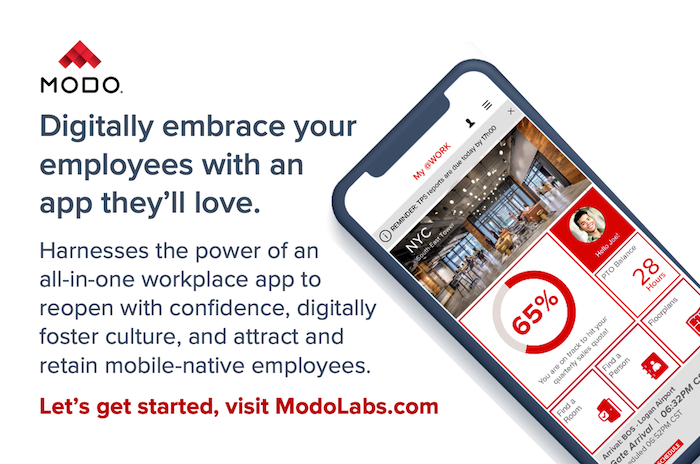By Rebecca Murtagh
When two global enterprises—a pharmaceutical company and a Fortune 100 financial firm— reached out to us, their overarching goals were common to many that use Modo: easily build a feature-rich, branded mobile app to drive employee productivity and keep them connected.
The Fortune 100 financial service organization first tried to build an app in-house, but eventually turned to our platform to provide the backbone. They used their workplace app to coordinate a massive back-to-the-office migration.
The pharmaceutical company also needed to support their return-to-office plan and realized that a mobile app was a critical element to making it happen. In less than 30 days, they were up and running and actively moving employees back to the office.
The common thread between these companies and the hundreds of others we work with is that their mobile app strategy was the critical link to executing employee-focused efforts like those to manage remote and hybrid workers, or to move them back to the office when the time is right. These are cross-departmental projects led by Human Resources, which has an eye on the employee experience. And, when the workplace app is one employees embrace because it delivers on the experience they desire, this also makes it an effective tool in the quest to find and retain talent.
What Employee Engagement Looks Like for the Remote or Hybrid Worker
What we are hearing from our customers particularly the HR staff tasked with mobile, is that employees now more than ever desire flexibility in how and where they work, which is a trend that was gaining momentum before the pandemic but became essential during the pandemic. As a result, companies have been innovating their workplace app experience to make it easier for remote employees to navigate through their workday as easily as those who are in the office. To make that experience successful, say HR leaders, a company’s mobile app needs these attributes:
- Collaborate – Empower employees to collaborate with and schedule in-office time with their cohorts.
- Connect – Ensure employees feel connected to their work, their colleagues and the company culture both globally and locally.
- Manage – Help employees go about their day, such as finding parking and transportation options, choosing where to eat, booking safe workspaces and conference rooms and locating co-workers.
- Access – Streamline and provide equitable access to needed information and resources and ensure employees are able to contribute equally to the business regardless of their location or time zone.
- Influence – Drive healthy choices and influence behaviors with nudges, quick polls, and service offerings.
- Assure – Make them feel comfortable about working near and around others in the office.
- Inform – Build employee confidence that they are safe by sending real-time localized mobile alerts.
- Engage – Provide satisfying engagement experiences, on par with how consumers engage with other mobile apps they use in their everyday life.
The Right Workplace Experience Attracts and Retains Top Talent
92 percent of HR leaders say the “employee experience” is a top priority in 2021. Data further supports what we’ve encountered with our customers: that employee expectations have changed dramatically since the pandemic started. Recruits are looking for a safe place to work and want a company that has a modern, feature-packed mobile app. That app should reflect what they value in a workplace. They want more than a job. They want an experience and flexibility in work hours and location without sacrificing the opportunity to connect with peers. And while companies have always included security features, employees today need assurances that these security and safety features will prevent transmission of the virus to them and the people they care about.
Employees move about the office differently now, too. They avoid crowded conference rooms and elevators and make decisions about where to go and when to come into the office based on if they will be safe and able to avoid illnesses. This means that mobile apps need to include the following:
- Provide intuitive access to key resources and optimize a hybrid environment – In addition to connecting to tools commonly used for scheduling and reserving conference rooms, a mobile workplace app needs an intuitive dashboard showing each employee their open tasks and their performance on those tasks. The app is also an effective way to drive behaviors – such as through push notifications – and solicit timely feedback through in-app surveys and quick polls. We call these “nudge” opportunities. Just as a Fitbit nudges the wearer to get up and walk around, workplace nudges can promote healthy behaviors and remind workers to wash their hands, to take a mental-health break, or to engage with their colleagues. With mobile, an app can send nudges telling workers when their cohorts will be in the office and that drives the organic collaboration and hallway conversations that feed innovation.
- Serve as a trusted source of information – Certain mobile app platforms make it easy for anyone in a company – such as HR – to keep the app updated and use it to deliver consistent communication. It is perfectly suited to automatically deliver information that is tailored to individuals based on their role and location, while also broadly communicating to all employees more quickly than emails.
- Inspire confidence that they will be safe coming to work – A mobile workplace app can prepare employees with what to expect when coming into the office, helping reduce their anxiety. It enables this in numerous ways, such as by serving up virtual tours on how to navigate their return and deliver wellness assessments and health check-ins. It can also assure them that the building and their workstations have been sanitized.
- Once in the office, empower employees to safely navigate office life – From the palm of their hands, employees can quickly find needed resources – including PPE – and with indoor wayfinding navigate new office layouts and protocols. They can know when it is safe to exit an elevator and when to approach a colleague’s work station. They can find where a colleague is located when they aren’t at their desk or in the office and they can request that their desk or a conference room be sanitized.
Meeting Employees Where They Are
Our phones are already our primary communication and connection tool. On average, we pick up our mobile phone 58 times per day, and more than half of those are during working hours. One study reveals 66 percent of Americans check their phones 160 times every day. And yet, deploying a mobile app need not be a tech-heavy endeavor requiring outside consultants and massive investment. HR leaders can spend time focusing on the experience. Instead of spending time with programming, HR can deliver a unified digital experience while fostering the corporate culture. And when it is well conceived and executed, your company workplace app not only helps current employees but sets your company apart with prospective ones.


